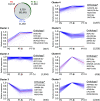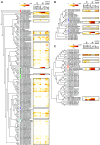Transcriptomic and Proteomic Insights into Amborella trichopoda Male Gametophyte Functions
- PMID: 32989009
- PMCID: PMC7723084
- DOI: 10.1104/pp.20.00837
Transcriptomic and Proteomic Insights into Amborella trichopoda Male Gametophyte Functions
Abstract
Flowering plants (angiosperms) are characterized by pollen tubes (PTs; male gametophytes) carrying two immobile sperm cells that grow over long distances through the carpel toward the ovules, where double fertilization is executed. It is not understood how these reproductive structures evolved, which genes occur de novo in male gametophytes of angiosperms, and to which extent PT functions are conserved among angiosperms. To contribute to a deeper understanding of the evolution of gametophyte functions, we generated RNA sequencing data from seven reproductive and two vegetative control tissues of the basal angiosperm Amborella trichopoda and complemented these with proteomic data of pollen grains (PGs) and PTs. The eudicot model plant Arabidopsis (Arabidopsis thaliana) served as a reference organism for data analysis, as more than 200 genes have been associated with male gametophyte functions in this species. We describe methods to collect bicellular A. trichopoda PGs, to induce their germination in vitro, and to monitor PT growth and germ cell division. Transcriptomic and proteomic analyses indicate that A. trichopoda PGs are prepared for germination requiring lipids, energy, but likely also reactive oxygen species, while PTs are especially characterized by catabolic/biosynthetic and transport processes including cell wall biosynthesis and gene regulation. Notably, a number of pollen-specific genes were lacking in Arabidopsis, and the number of genes involved in pollen signaling is significantly reduced in A. trichopoda In conclusion, we provide insight into male gametophyte functions of the most basal angiosperm and establish a valuable resource for future studies on the evolution of flowering plants.
© 2020 American Society of Plant Biologists. All Rights Reserved.
Figures







Similar articles
-
Comparative analyses of angiosperm secretomes identify apoplastic pollen tube functions and novel secreted peptides.Plant Reprod. 2021 Mar;34(1):47-60. doi: 10.1007/s00497-020-00399-5. Epub 2020 Nov 30. Plant Reprod. 2021. PMID: 33258014 Free PMC article.
-
Comprehensive analysis of tobacco pollen transcriptome unveils common pathways in polar cell expansion and underlying heterochronic shift during spermatogenesis.BMC Plant Biol. 2012 Feb 16;12:24. doi: 10.1186/1471-2229-12-24. BMC Plant Biol. 2012. PMID: 22340370 Free PMC article.
-
Female gamete competition in an ancient angiosperm lineage.Proc Natl Acad Sci U S A. 2011 Jul 26;108(30):12360-5. doi: 10.1073/pnas.1104697108. Epub 2011 Jun 20. Proc Natl Acad Sci U S A. 2011. PMID: 21690400 Free PMC article.
-
The Role of Female and Male Genes in Regulating Pollen Tube Guidance in Flowering Plants.Genes (Basel). 2024 Oct 24;15(11):1367. doi: 10.3390/genes15111367. Genes (Basel). 2024. PMID: 39596567 Free PMC article. Review.
-
Using maize as a model to study pollen tube growth and guidance, cross-incompatibility and sperm delivery in grasses.Ann Bot. 2011 Sep;108(4):727-37. doi: 10.1093/aob/mcr017. Epub 2011 Feb 23. Ann Bot. 2011. PMID: 21345919 Free PMC article. Review.
Cited by
-
Insights into genetics of floral development in Amborella trichopoda Baill. through genome-wide survey and expression analysis of MADS-Box transcription factors.Sci Rep. 2025 Feb 12;15(1):5297. doi: 10.1038/s41598-025-88880-x. Sci Rep. 2025. PMID: 39939686 Free PMC article.
-
Heat stress at the bicellular stage inhibits sperm cell development and transport into pollen tubes.Plant Physiol. 2024 Jun 28;195(3):2111-2128. doi: 10.1093/plphys/kiae087. Plant Physiol. 2024. PMID: 38366643 Free PMC article.
-
ZW sex chromosome structure in Amborella trichopoda.Nat Plants. 2024 Dec;10(12):1944-1954. doi: 10.1038/s41477-024-01858-x. Epub 2024 Nov 25. Nat Plants. 2024. PMID: 39587314 Free PMC article.
-
Comparative analyses of angiosperm secretomes identify apoplastic pollen tube functions and novel secreted peptides.Plant Reprod. 2021 Mar;34(1):47-60. doi: 10.1007/s00497-020-00399-5. Epub 2020 Nov 30. Plant Reprod. 2021. PMID: 33258014 Free PMC article.
-
SEC1A is a major Arabidopsis Sec1/Munc18 gene in vesicle trafficking during pollen tube tip growth.Plant J. 2022 Jun;110(5):1353-1369. doi: 10.1111/tpj.15742. Epub 2022 Apr 6. Plant J. 2022. PMID: 35306707 Free PMC article.
References
-
- Amborella Genome Project (2013) The Amborella genome and the evolution of flowering plants. Science 342: 1241089. - PubMed
-
- Benjamini Y, Hochberg Y(1995) Controlling the false discovery rate: A practical and powerful approach to multiple testing. J R Stat Soc B 57: 289–300
Publication types
MeSH terms
LinkOut - more resources
Full Text Sources

